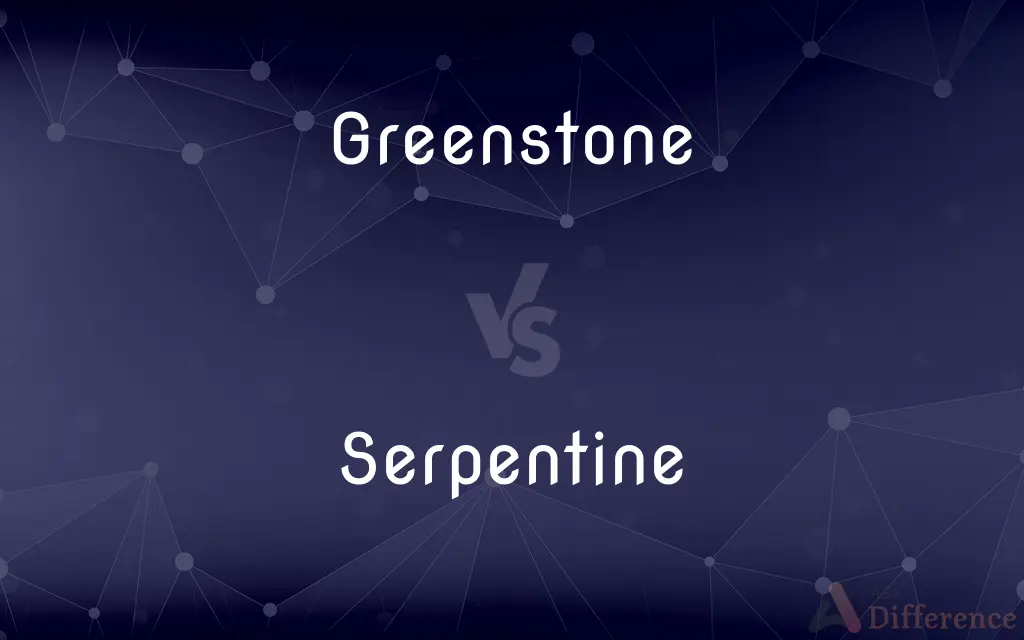Greenstone vs. Serpentine — What's the Difference?
Edited by Tayyaba Rehman — By Urooj Arif — Updated on April 3, 2024
Greenstone vs. Serpentine: Greenstone is a broad term for metamorphic rocks rich in green minerals, while Serpentine refers to a group of minerals forming green to greenish-black rocks.

Difference Between Greenstone and Serpentine
Table of Contents
ADVERTISEMENT
Key Differences
Greenstone encompasses a wide range of metamorphic rocks that are green due to their chlorite, actinolite, and epidote content. These rocks are typically formed under low-grade metamorphic conditions and can include various rock types like schists and basalts. Serpentine, on the other hand, specifically refers to a group of minerals that are commonly found in metamorphosed ultramafic rocks. These minerals are characterized by their green color and smooth or scaly appearance.
Greenstone's green color primarily comes from chlorite, actinolite, and sometimes epidote, which are formed under specific metamorphic conditions. This gives greenstone its distinctive greenish hue. Serpentine minerals also impart a green color to rocks, but this comes from magnesium iron silicate minerals that have undergone hydrothermal metamorphism. The color and texture of serpentine are unique, ranging from translucent to opaque and from smooth to fibrous.
In terms of geology, greenstone belts are significant as they often contain valuable mineral deposits such as gold and copper. These belts represent ancient volcanic zones where the greenstones were formed. Serpentine rocks, however, are often associated with the presence of asbestos, a hazardous material, and are less known for containing valuable ores. The formation process of serpentine involves the alteration of ultramafic rocks from the Earth's mantle, making it common in ophiolite complexes.
From a cultural and historical perspective, both greenstone and serpentine have been valued for their beauty and durability. Greenstone, especially in New Zealand where it is known as pounamu, holds great cultural significance to the Māori people and is used in carvings and jewelry. Serpentine has been used in decorative arts and architecture, valued for its attractive green color and patterns.
The environments where greenstone and serpentine form are quite different, leading to distinct ecosystems. Serpentine soils, derived from serpentine rocks, are known for their high magnesium and low calcium levels, which can be toxic to many plants. However, these soils also support unique plant communities adapted to these conditions. Greenstone, being less chemically distinct from its surroundings, does not have as pronounced an effect on the local ecology.
ADVERTISEMENT
Comparison Chart
Composition
Primarily chlorite, actinolite, epidote
Magnesium iron silicate minerals
Color
Green to greenish-black
Green, ranging from translucent to opaque
Formation
Low-grade metamorphism of volcanic rocks
Hydrothermal metamorphism of ultramafic rocks
Cultural Significance
Highly valued in Māori culture (New Zealand)
Used in decorative arts and architecture
Ecological Impact
Minimal specific impact
Creates unique, adapted plant communities on serpentine soils
Compare with Definitions
Greenstone
Rocks used historically for tools and ornaments.
Ancient tools found at the site were made of greenstone.
Serpentine
A group of minerals known for their green color and slippery feel.
The serpentine rock had a smooth, waxy surface.
Greenstone
A term used in geology to describe certain metamorphic rocks.
The sample was identified as greenstone due to its green minerals.
Serpentine
Rocks composed predominantly of serpentine minerals.
The cliff was composed of dark, serpentine rock.
Greenstone
Any rock within greenstone belts, usually of volcanic origin.
Geologists study greenstones to understand ancient volcanic activities.
Serpentine
A material historically used in decorative arts.
The vase was carved from a block of serpentine.
Greenstone
A metamorphic rock, often green, rich in chlorite, actinolite, and epidote.
The greenstone necklace held significant cultural value.
Serpentine
Associated with asbestos and certain environmental issues.
The old building’s serpentine tiles had to be removed safely.
Greenstone
A symbol of status and identity in some cultures.
The chief wore a greenstone pendant as a symbol of leadership.
Serpentine
Supports unique ecosystems due to its chemical properties.
The serpentine soil was home to several rare plant species.
Greenstone
Any of various altered basic igneous rocks colored green by chlorite, hornblende, or epidote.
Serpentine
Of or resembling a serpent, as in form or movement; sinuous.
Greenstone
(archaeology) any of several green-hued minerals used for making various artefacts in early Mesoamerican cultures, e.g. greenschist, chlorastrolite, serpentine, omphacite, or chrysoprase
Serpentine
Subtly sly and tempting.
Greenstone
(New Zealand) pounamu, the green-hued minerals of New Zealand used by Māori to make tools, ornaments and weapons (any of three varieties of nephrite jade or one variety of bowenite)
Serpentine
Relating to or associated with serpentinite or soil derived from it.
Greenstone
A name formerly applied rather loosely to certain dark-colored igneous rocks, including diorite, diabase, etc.
Serpentine
Any of a group of greenish, brownish, or mottled minerals, Mg3Si2O5(OH)4, including chrysotile, a variety of asbestos.
Serpentine
A metamorphic rock containing serpentine minerals; serpentinite.
Serpentine
Of, pertaining to, or characteristic of snakes.
Serpentine
Of, or having attributes associated with, the serpent referred to in the book of Genesis in the Bible, such as craftiness or deceitfulness.
The wily criminal was known for his serpentine behavior.
Serpentine
Having the form or shape of a snake.
There are serpentine species of lizards which do not have legs.
Serpentine
Curving in alternate directions; sinuous.
The serpentine path through the mountains was narrow and dangerous.
Serpentine
Any of several plants believed to cure snakebites.
Serpentine
(historical) An early form of cannon, used in the 16th century.
Serpentine
A kind of firework.
Serpentine
A coiled distillation tube.
Serpentine
(maths) Any of several related cubic curves; anguinea Category:en:Curves
Serpentine
(equestrian) In dressage, a winding walk across on the arena.
Serpentine
(mineralogy) Any of several green/brown minerals consisting of magnesium and iron silicates that have similar layered crystal structure, whose appearance somewhat resembles a snake's skin.
Serpentine
(geology) An outcrop or region with soil and rock dominated by these minerals.
Serpentine
(archaic) To serpentize; to turn or bend; to meander.
Serpentine
Resembling a serpent; having the shape or qualities of a serpent; subtle; winding or turning one way and the other, like a moving serpent; anfractuous; meandering; sinuous; zigzag; as, serpentine braid.
Thy shapeLike his, and color serpentine.
Serpentine
A mineral or rock consisting chiefly of the hydrous silicate of magnesia. It is usually of an obscure green color, often with a spotted or mottled appearance resembling a serpent's skin. Precious, or noble, serpentine is translucent and of a rich oil-green color.
Serpentine
A kind of ancient cannon.
Serpentine
To serpentize.
Serpentine
Resembling a serpent in form;
A serpentine wall
Snaky ridges in the sand
Common Curiosities
Can both greenstone and serpentine be used for carving?
Yes, both have been historically used for carving tools, ornaments, and decorative items.
Is serpentine dangerous?
Some forms of serpentine can contain asbestos, which is hazardous to human health when airborne.
What gives greenstone its color?
The green color in greenstone is primarily due to chlorite, actinolite, and sometimes epidote.
What makes serpentine soils unique?
Serpentine soils have high magnesium and low calcium levels, supporting unique plant life.
Why is greenstone important in New Zealand?
In New Zealand, greenstone (pounamu) is of great cultural significance to the Māori people.
What is serpentine commonly used for?
Serpentine has been used in decorative arts, architecture, and historically, even in jewelry.
Do greenstone and serpentine have the same hardness?
The hardness can vary within each group but generally, serpentine is softer and easier to carve than some greenstones.
Can greenstone contain valuable minerals?
Yes, greenstone belts often contain valuable mineral deposits such as gold and copper.
Are greenstones always green?
Yes, greenstones are named for their characteristic green hue, though the shade can vary.
Where are greenstone belts found?
Greenstone belts are found in ancient volcanic zones, including parts of Canada, Australia, and South Africa.
What is the difference between greenstone and jade?
While both are green and used similarly in cultures, jade refers to nephrite or jadeite minerals, which have different compositions and properties than greenstone.
What ecological impact does serpentine have?
Serpentine soils create unique ecosystems due to their chemical makeup.
How are serpentine minerals formed?
Serpentine minerals are formed through the hydrothermal metamorphism of ultramafic rocks.
How are greenstones formed?
Greenstones are formed through the low-grade metamorphism of volcanic rocks, including basalts and andesites.
Are all serpentine minerals green?
Most serpentine minerals are green, but variations in shade and opacity can occur.
Share Your Discovery

Previous Comparison
Eland vs. Kudu
Next Comparison
Hash vs. DashAuthor Spotlight
Written by
Urooj ArifUrooj is a skilled content writer at Ask Difference, known for her exceptional ability to simplify complex topics into engaging and informative content. With a passion for research and a flair for clear, concise writing, she consistently delivers articles that resonate with our diverse audience.
Edited by
Tayyaba RehmanTayyaba Rehman is a distinguished writer, currently serving as a primary contributor to askdifference.com. As a researcher in semantics and etymology, Tayyaba's passion for the complexity of languages and their distinctions has found a perfect home on the platform. Tayyaba delves into the intricacies of language, distinguishing between commonly confused words and phrases, thereby providing clarity for readers worldwide.
















































